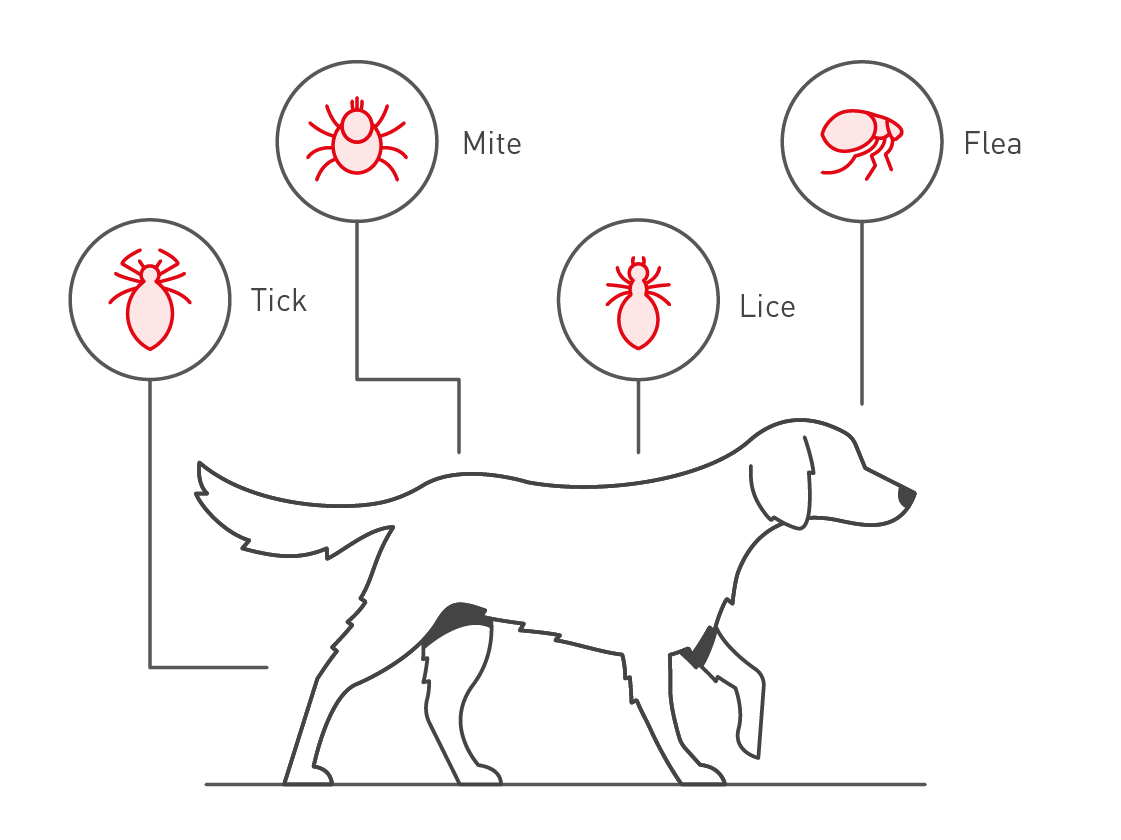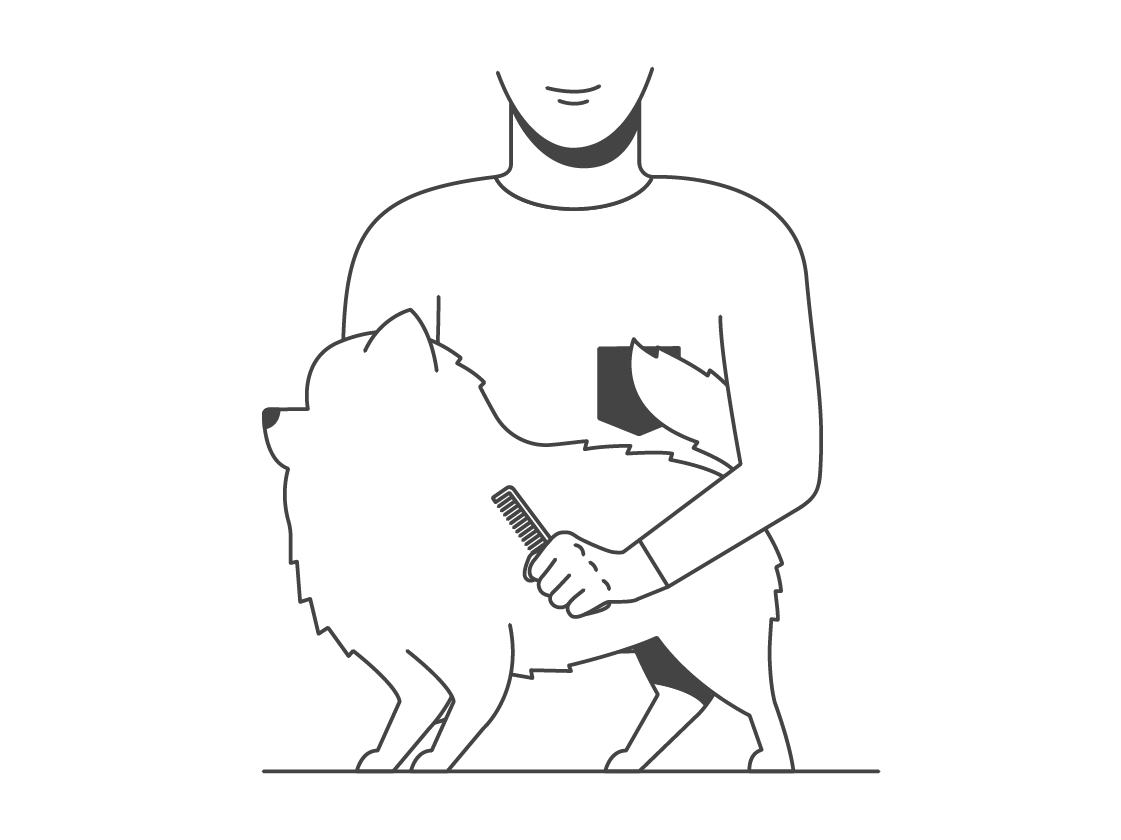An Introduction to Dog Parasites
Article

Parasites such as fleas, ticks, lice and mites are a common irritant for dogs (and their owners). However, with the right information and guidance they can be dealt with quickly and efficiently, relieving pain and irritation for dogs.
Understanding the Difference between Dog Parasites
There are four common external parasites to be aware of that could infest your dog.
Fleas
Fleas feed off the blood of their hosts. There are over 2,500 known species of these tiny parasites1 – although ironically, the species most commonly found on dogs is the “cat flea”. Cat fleas are known to infest various mammals and birds worldwide, giving your dog plenty of opportunity to pick them up and pass them on to other animals whenever they leave the house.
Ticks
Ticks are small, spider-like parasites that, like fleas, will hide on your dog and feed off their blood. They have six or eight legs (depending on how old they are), with an egg-shaped body that grows larger and darker the more blood they consume.
Unlike fleas, dog ticks don't fly or jump. They tend to live in places with long grass, like woodlands or grasslands, and will crawl onto a host whenever they come into contact with one. Ticks can live on many different species so are common in areas with lots of wildlife and farm animals.
Lice
Dog lice are tiny, external parasites that live on your dog’s skin and hair coat. They chew on the dog’s skin or suck its blood, causing skin irritation, itching and, in severe infestations, anemia. Infestations are not common in clean, healthy dogs, and are more likely to affect those in warmer environments. Infestations are also more common when animals are in poor physical condition2.
Dog Ear Mites
Ear mites can only be identified under a microscope. They are highly contagious parasites that live in your dog’s ear canals, and occasionally on other skin surfaces. Ear mites feed on your dog’s skin and ear surface debris, causing inflammation and irritation.
Ear mites can live for approximately two months3. Dogs usually get ear mites by being around other animals that are infected, especially if they sleep in the same area or bed. Since dog ear mites are highly contagious, if your dog is diagnosed with them, it’s advisable to get all of your other pets checked at the same time to ensure you eliminate them completely from your home.
If you’d like to read more about the different types of parasites and the effects they can have on your dog’s skin, you can do so here.

Spotting Parasites on Your Dog
Spotting the common signs of a parasite infestation means veterinary assistance can be sought as soon as possible to relieve any discomfort.
Fleas
How do you know if your dog has fleas? They aren’t always easy to spot, but there are lots of other ways you can look out for fleas on your dog. Itchy skin is a well-known symptom, so take note of any severe scratching, itching, or if your dog seems to be biting or chewing their skin excessively, especially the caudal (rear) half. Hair loss, scabs or red, irritated skin are also signs that your dog
might have fleas.
If you can’t spot the fleas themselves, you can search for flea droppings instead, which will look like flecks of pepper sprinkled over your dog’s body – most likely in the neck, ears, lower back, abdomen and base of the tail, all of which are areas fleas like to hide in. You can also comb your dog with a fine-toothed flea comb, which will pick up fleas and flea dirt, making it easy for you to see evidence of any flea activity.
Speaking to a vet means that the flea infestation can be resolved quickly and efficiently, and the sooner your dog’s comfort and quality of life will be restored. You can also read our article on how to check your dog for fleas (and what to do if you find them) here.
Ticks
Although there are different types of ticks, they are usually round and shiny, with a small head and a large, flattened body. They can be brown, pink, purple or bluish-grey in color, and are typically found near a dog’s neck, head, ears or under the legs.
A tick is approximately the size of a pinhead when it first attaches itself to your dog, however, it can grow to the size of a small pea as it feeds. Ticks can be tricky to spot until they get quite big, which is why it’s important to check your dog regularly, especially after walks in long grass. If your dog is licking or chewing itself more than usual, or you see signs of red, inflamed skin, scabs or head shaking, it’s possible a tick may be hiding somewhere on their body.
Lice
Adult dog lice are usually large enough to see, and range from yellow to tan to medium brown in color (making them easily distinguishable from fleas, which are almost black). You should be able to see lice by parting your dog’s hair and examining the hair shaft.
Dog lice and their eggs are sometimes mistaken for dandruff – so to determine whether your dog has lice, you can collect hair from its grooming brush or comb and give it a shake. If small flakes fall off the hair, it’s dandruff. If the flakes cling stubbornly to the hair, it is more likely to be lice. Other signs of dog lice infestations can include itching, scratching or biting, hair loss, a dry coat, skin redness or matted fur, restlessness, anemia or lethargy.
Dog Ear mites
A dog with an ear infection can have the same symptoms – scratching and/or ear discharge – as one with dog ear mites. If your dog exhibits either of these signs, it’s advisable to speak to your vet to get a proper diagnosis and treatment.
Remember, although itchy skin is often a sign of a parasite infestation, it could also be attributed to other dermatology issues, so it’s important to speak to your vet to determine the true cause. If you’d like to read more about dermatitis and other skin issues in dogs, you can find additional information here.

How to Stop Dog Parasites from Returning
No matter which type of parasites you think your dog is infested with, you should seek the advice of your vet. They’ll be able to provide the necessary management to remove the identified parasite. Once your dog has been treated, there are also some proactive measures you can take to help stop parasites from returning.
Fleas
From pills and collars to prescription applications, there are lots of options available to protect your dog and your home from flea infestations, which are much easier (and cheaper) to deal with than a full-blown flea problem. You can find more information on how to get rid of fleas here, but remember to speak to your vet about the best management options for your dog.
Ticks
There’s no way to stop your pet from getting ticks completely, but there’s a lot you can do to reduce the risk – for example avoiding long grass and sticking to paths or open spaces. You should also check your dog for ticks after walks, paying close attention to places they are most commonly found – the head, ears, armpits, groin and tummy.
If your dog does pick up a tick, there are several products, such as collars, tablets, and spot-on treatments, that are highly effective at killing ticks. Certain products may also provide help before the tick has been attached long enough to spread the disease. Many tick treatments also provide protection against other dog parasites such as fleas – but as always, speak to your vet to find the right treatment for your dog.
Lice
Lice can be treated relatively easily. Your vet should be able to supply you with instructions – there are plenty of shampoos, sprays and powders available that are effective in killing lice.
To avoid re-infection after your dog has been treated, it’s important to clean any place they spend time; wash all bedding and clean carpets, floors, rugs, furniture and even outdoor surfaces thoroughly. Some vets also recommend replacing your grooming tools as it can be difficult to remove the sticky eggs from combs and brushes.
Ear mites
Most dogs make a relatively quick, uneventful recovery from ear mites, although some may need another trip to the vet to flush out any residual debris in their ear canal.
Remember that in addition to eradicating adult ear mites, you will also need to eliminate any eggs that could hatch in the near future. Make sure you wash items like your dog’s bedding in hot water and thoroughly vacuum areas where your dog spends a lot of time.
After treatment, continue to check your dog’s ears regularly for signs of ear mites – in particular, keep an eye out for discharge or redness within the ear canal and head shaking or scratching around the ears.

Article References
1Iannino F, Sulli N, Maitino A, Pascucci I, Pampiglione G, Salucci S. Fleas of dog and cat: species, biology and flea-borne diseases. Vet Ital. 2017 Dec 29;53(4):277-288. doi: 10.12834/VetIt.109.303.3. PMID: 29307121.
2Thomas, J. E. (2015, June). Lice in dogs and cats-Integumentary System. MSD Veterinary Manual. Retrieved June 14, 2022, from https://www.msdvetmanual.com/integumentary-system/lice/lice-in-dogs-and-cats
3Kwochka KW. Mites and related disease. Vet Clin North Am Small Anim Pract. 1987 Nov;17(6):1263-84. doi: 10.1016/s0195-5616(87)50002-x. PMID: 3328389.
Related Articles
Like & share this page